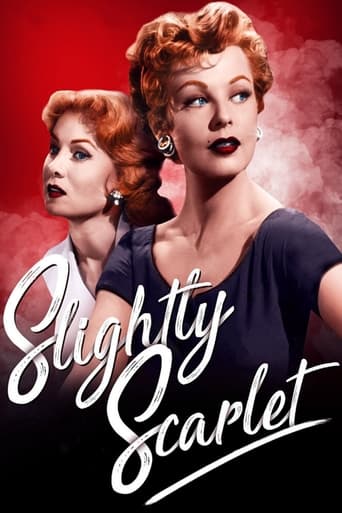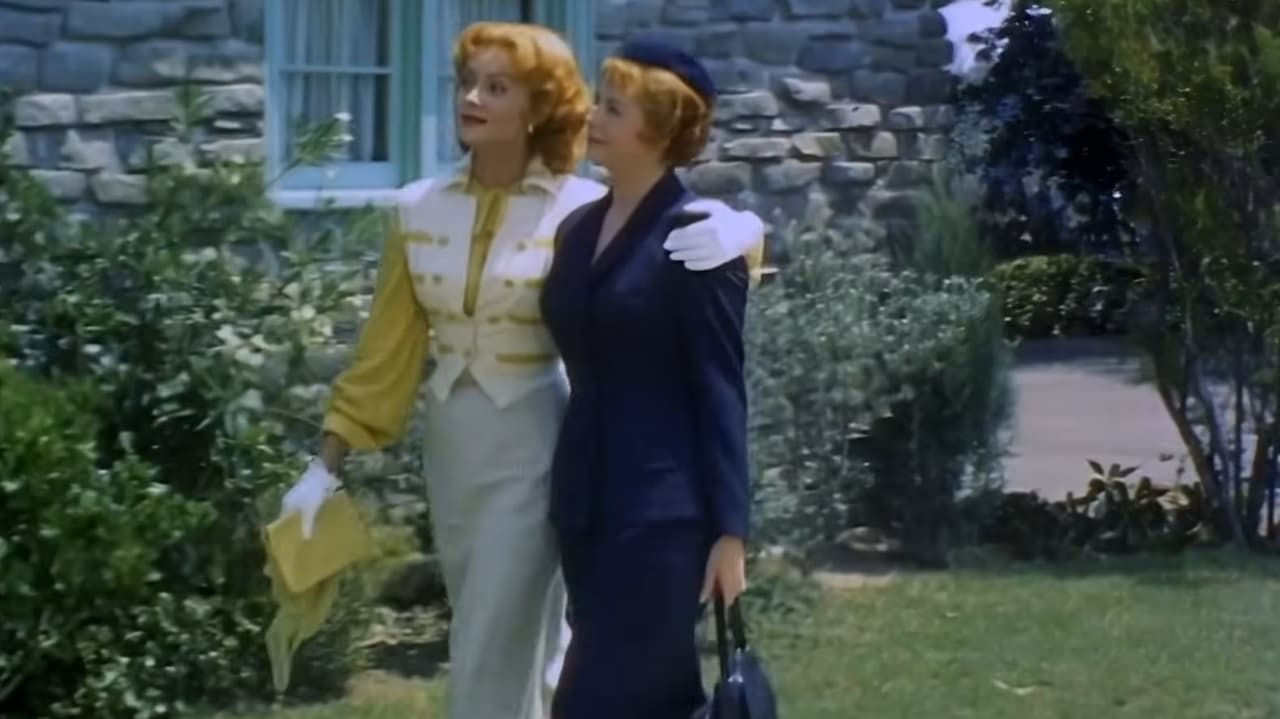secondtake
Slightly Scarlet (1956)A drippy Technicolor melodrama from the early widescreen era, with crossed purposes and crossed stars? Sounds like Douglas Sirk, yes, but this lacks the depth and dreamy romance (and loneliness) of his films, and the seeming irony. This is really a kind of late film noir, though the themes of that era are diffused so it ends up mostly a crime drama with emphasis on the emotional troubles of the leading women. It's interesting more than compelling, but it is interesting.It's hard to say if this is a John Alton movie, or a James M. Cain movie. The leading women with their almost scarlet hair (in Technicolor, which was unusual for RKO), are certainly not what makes this movie float, though they try very hard. And it's not John Payne, the leading man who is his usual understated self.I'll go with Alton, the cinematographer, who transfers with some success the film noir feeling to color. Maybe too literally. Sometimes the shadows on the walls are caricatures of the old days, references to noir but not purely ominous. (In this way the movie really is like a Sirk film, which seems to confess an end-of-Hollywood decadence.) But in all the film looks very good—the shots, the editing, the color coordination (thanks to Technicolor's advisors), and the sets, which are quite deliberately distracting. (In this sense, it's again not a noir where the shadows hide the details—details abound.)The plot, which I seem to be avoiding, is a bit strained, and even a bit confusing, and this is Cain's doing, and the screenwriter's. It's not that you can't follow, but that you wonder what people's motivations are. Payne plays a lowly henchman of a crime boss running to be re-elected mayor, and he mostly digs up dirt on enemies (by spying with camera and tape recorder). Events turn quickly and he's, what? running the whole underground racket? Yes, but only after cleaning it up a bit. And so allegiances flip flop and his girlfriend (one of the sisters) doesn't seem to notice.The sisters are the centerpiece in a way—one has just gotten out of jail and the other is trying to help her. But naturally the "bad" one can't stay out of trouble, small stuff. One thing leads to another, sort of, but it doesn't much matter. What does matter is their interaction, and the overacted and rather fun performance by the "bad" sister, played by Arlene Dahl. Revenge and a few gunshots and gasping last thoughts and you have it. So watch this from above, as a kind of low-grade spectacle. It's so vivid and well- meant somehow you can't help be curious. And you won't stop watching, I think. But you'll end up wondering why exactly it got made. This is one RKO's last films, and it feels like a last gasp.
chaos-rampant
Noir is by definition loopy; dead protagonists narrating from inside a pool, or showing up in a police station to report their own murder, the genre usually tangles its narratives in the steaming bedsheets of an emotional hotbed. We just writhe with them. In the best noirs, we writhe with them in the effort to disentangle ourselves from the cosmic strings that pull us.This is seriously loopy stuff, albeit awkwardly incompetent compared to the searing visions of Sunset Blvd. There is a protagonist who starts out a henchman of the evil kingpin, redeems himself, only to assume his place. Eventually he runs off like a scoundrel - he just isn't carrying this in any way.There is the convoluted plot about scheming and political intrigue in sunny California. Greed and ambition, the tropes. It's a far-fetched, dimestore thing, the kind of which James Ellroy would later simply obliterate as perversely glamorous background against senseless violence.Two things that strike some spark, one is the the two flaming redheads, sisters looking through sex for an entry into the world of money and standing. One is a kleptomaniac fresh out of prison, who wants to steal the other's man. They both sizzle in skimpy shorts and revealing dresses, sultry and dangerous like cutouts from the pages of a pinup comic.And there is the architecture that upends everything and nullifies it. Two houses, impossibly large and drowned in extravagant decoration. One of them is kept by a secretary, a really curious place to be sustained at a secretary's salary. But it's precisely this that is the movie's token, the candy-colored movie fantasy where everything is so simplistically possible and the small nuance of life is sacrificed for the sake of blistering outbursts. The wild colors, curtesy of famous DP John Alton, abet the artificial passions and overwrought cruelties.
spelvini
The 1956 film "Slightly Scarlet" at first glance looking back from our sophisticated perspective today seems to be a bit of a tongue-in cheek joke.Directed by Allan Dwan from a Robert Blees screenplay adapted from James M. Cain's novel "Love's Lovely Counterfeit", the 99-minute film is a great combination of color and art direction in a film noir.Not a highly regarded film noir, in Technicolor and Superscope its palette utilizes a wide range of color to support the individual themes and characterizations.Our main characters have color scheme that establish them and develop with the story.Arlene Dahl as Dorothy wears black as she is released from prison and even sports a black bathing suit later in the film.Rhonda Flemming as June initially appears in Spring-like colors of off-white and yellow, with colors matching her mood as the film progresses. She wears white and blues when she meets Ben Grace for the first time, then black and off-white when they kiss and she begins to fall in love with him. When Dorothy is arrested Rhonda wears a grey sweater and skirt but by the end of the film June wears the same black color as Dorothy emphasizing her relationship to her bad sister.Although the pivotal action of the film rests on Ben Grace, it is through June that we understand the important elements of the story, and the value of good and bad in this noir world as well as our own.A study in duality, it falls short by not delivering what it promises but only shifts the pivotal actions onto the male character in the film.In more than one scene characters tell Ben Grace that he is taking advantage of the situations around him to unfair terms.Police man Dietz (Frank Gerstle), who Grace gets put into a high-ranking position accuses Ben of playing both ends toward the middle.A great line from Sole Caspar to Ben Grace sums up his character completely: "Genius you're just a chiseler out for a soft spot. You're not crooked and you're not straight. You take what you can get where you can get it but you don't want any trouble. You'll die at age 66 with three grand in the bank but you'll never be an operator." Looking back its moments of plot change create humor because of the style of acting and the overall writing in the script.But there is still ample example of real noir elements despite the color of the film.The title suggests the slightly scarlet is a pun on the pure heart of the lead female as measured against the overall 'sick' nature of her sister, the one who steals.The quality of the motivation to steal of the second female lead as compared against the organized mob activities of the lead crook is an interesting one. There is the opportunity foe the woman to become the girlfriend of the mob boss, and she seems perfectly matched for the role.
jaguar-4
Two red-headed sisters, wild colors everywhere (?), no nonsense gangster pol lets himself be dragged around by the manic nympho sister (he dates the busty mature book-on-her-head walkin' sister). Camp, would do well restaged by a drag group (if it hasn't been already) except that I don't think too many people know the original. Arlene DAHL was never like this! No filmic nympho is quite as fruity as she. It's a rare sister vs. sister pre Baby Jane. It's a scream-with-laughter surprise of a film -- please watch it with a bunch of friends. It has been shown on AMC; don't know if it's on tape.


 AD
AD



